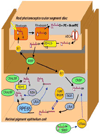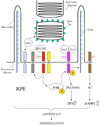The retinal pigment epithelium in health and disease
- PMID: 21091424
- PMCID: PMC4120883
- DOI: 10.2174/156652410793937813
The retinal pigment epithelium in health and disease
Abstract
Retinal pigment epithelial cells (RPE) constitute a simple layer of cuboidal cells that are strategically situated behind the photoreceptor (PR) cells. The inconspicuousness of this monolayer contrasts sharply with its importance [1]. The relationship between the RPE and PR cells is crucial to sight; this is evident from basic and clinical studies demonstrating that primary dysfunctioning of the RPE can result in visual cell death and blindness. RPE cells carry out many functions including the conversion and storage of retinoid, the phagocytosis of shed PR outer segment membrane, the absorption of scattered light, ion and fluid transport and RPE-PR apposition. The magnitude of the demands imposed on this single layer of cells in order to execute these tasks, will become apparent to the reader of this review as will the number of clinical disorders that take origin from these cells.
Figures




References
-
- Anderson DH, Fisher SK. The relationship of primate foveal cones to the pigment epithelium. J Ultrastruct Res. 1979;67:23–32. - PubMed
-
- Miller SS, Steinberg RH. Passive ionic properties of frog retinal pigment epithelium. J Membr Biol. 1977;36:337–372. - PubMed
-
- Shin K, Fogg VC, Margolis B. Tight junctions and cell polarity. Ann Rev Cell Develop Biol. 2006;22:207–235. - PubMed
-
- Rizzolo LJ. Development and role of tight junctions in the retinal pigment epithelium. Int Rev Cytol. 2007;258:195–234. - PubMed
Publication types
MeSH terms
Substances
Grants and funding
LinkOut - more resources
Full Text Sources
Other Literature Sources
Medical
Research Materials
